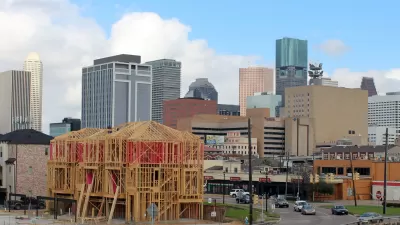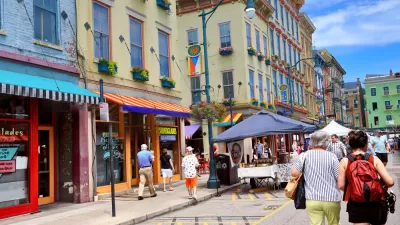While the southern end of the thoroughfare is seeing rapid redevelopment and gentrification, the northern end has yet to reap any benefits from the nearby projects.

Cincinnati's Vine Street is starting to show a stark divide between its gentrifying southern end and the largely ignored section north of Liberty Street, reports Monique John for WCPO Cincinnati. In 2001, the fatal shooting of Timothy Thomas by a Cincinnati police officer sparked days of protests in the neighborhood. "The gentrification that took place on Vine south of Liberty can be explained as an attempt toward social reform triggered by Thomas’s killing." But despite the transformations happening a block away, John writes, "Northern Vine has remained in its distressed state."
Andy Hutzel, director of resident services at Over-the-Rhine Community Housing, contends that the historic nature of the housing stock on Northern Vine plays a role in the slow redevelopment of the area, explaining that "rehabilitating old buildings that dominate OTR comes at a hefty price." Local stakeholders are hopeful that plans to extend revitalization efforts to the north will come to fruition soon, and "experts project that the urban core’s rapid development in recent decades likely will not slow down as it moves into the northern portion of Over-the-Rhine."
Other locals worry about the displacement and higher cost of living that usually come with redevelopment. "Vulnerable residents are hungrier for amenities like laundromats, social spaces, and food establishments that they can afford." To address these concerns, "investing in affordable housing will be key to protecting vulnerable residents like those living on or near northern Vine from the drastic changes to come."
FULL STORY: Will gentrification keep climbing up Over-the-Rhine's Vine Street?

Study: Maui’s Plan to Convert Vacation Rentals to Long-Term Housing Could Cause Nearly $1 Billion Economic Loss
The plan would reduce visitor accommodation by 25,% resulting in 1,900 jobs lost.

North Texas Transit Leaders Tout Benefits of TOD for Growing Region
At a summit focused on transit-oriented development, policymakers discussed how North Texas’ expanded light rail system can serve as a tool for economic growth.

Using Old Oil and Gas Wells for Green Energy Storage
Penn State researchers have found that repurposing abandoned oil and gas wells for geothermal-assisted compressed-air energy storage can boost efficiency, reduce environmental risks, and support clean energy and job transitions.

From Blight to Benefit: Early Results From California’s Equitable Cleanup Program
The Equitable Community Revitalization Grant (ECRG) program is reshaping brownfield redevelopment by prioritizing projects in low-income and environmental justice communities, emphasizing equity, transparency, and community benefits.

Planting Relief: Tackling Las Vegas Heat One Tree at a Time
Nevada Plants, a Las Vegas-based nonprofit, is combating the city’s extreme urban heat by giving away trees to residents in underserved neighborhoods, promoting shade, sustainability, and community health.

How Madison’s Tree Planting Efforts Are Growing a Healthier Community
Madison’s annual tree planting initiative is enhancing environmental resilience, public health, and community livability by adding 1,400 carefully selected trees citywide, with strong community and institutional support for urban forestry.
Urban Design for Planners 1: Software Tools
This six-course series explores essential urban design concepts using open source software and equips planners with the tools they need to participate fully in the urban design process.
Planning for Universal Design
Learn the tools for implementing Universal Design in planning regulations.
Ascent Environmental
Borough of Carlisle
Institute for Housing and Urban Development Studies (IHS)
City of Grandview
Harvard GSD Executive Education
Toledo-Lucas County Plan Commissions
Salt Lake City
NYU Wagner Graduate School of Public Service





























